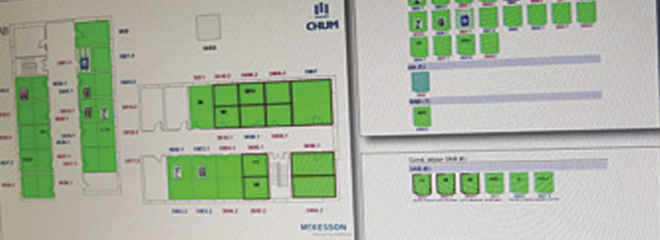By Susan Usher, Esther Leclerc, Thierry Guyader, Guy Paré
This case study, prepared by Health Innovation Forum with contributions from Ms. Esther Leclerc, Assistant Director General at the CHUM, and Mr. Thierry Guyader, Director, Healthcare Improvement Division, McKesson, examines the Centre hospitalier de l’Université de Montréal (CHUM) partnership with McKesson to implement real-time information displays for greater efficiency in patient flow. — Produced as part of the series: "Partnerships to Enhance Health System Performance."
Challenge
When patients arrive at the hospital, the goal is to find them a bed in a care unit as quickly as possible. The coordinated activities of a broad range of personnel are involved in this effort. While some admissions are scheduled ahead of time, The Canadian Institute for Health Information (CIHI) estimates that up to 60% of all hospital admissions arrive through the emergency department (ED).
This de facto front door to hospital care is hardly welcoming. CIHI reports, in Understanding Emergency Department Wait Times, that across Canada, only 10% of ED patients requiring admission are immediately transferred to an acute care bed. In Quebec, targets have been set for reducing waits but hospitals still fall far short of meeting them. In the meantime, patients line the ED hallways on stretchers. While some of the factors involved in long waits for beds lie outside the hospital, internally the goal is to optimize patient flow and efficiency.
“Our ongoing challenge is to maintain quality and improve efficiency without constantly increasing human resources,” says Esther Leclerc, Assistant Director General at the Centre hospitalier de l’Université de Montréal (CHUM). “We need to find ways to free up time for our existing personnel. Outside the health system, the information age has made work much more efficient. We need to make that possible within our hospitals.”
Ms. Leclerc recognizes that information sharing is essential to behaviour changes that are key to improving patient flow and bed management. Everyone from the treating physician to the cleaning staff has a role to play in optimizing efficiency, but communication between the relevant players is uneven and difficult. When will this patient be discharged? Which bed should I clean next? How many rooms need thorough disinfection? Can I transfer an ED patient up to the unit? Multiple telephone calls are required for staff to track down information needed to perform their various duties and managers and administrators have no global view of what’s going on in the hospital. Ms. Leclerc was looking for ways to make this type of information available to all personnel in real time, improve coordination and thereby get people out of the ED hallways faster. And she needed a solution that wouldn’t increase staff costs.
Intent on improving efficiency in hospitals to reduce wait times, the Ministère de la Santé et des Services sociaux (MSSS) in Quebec along with the Agence de la Santé et des Services sociaux (ASSS) in Montreal, following on the significant reorganization undertaken with support from McKinsey in 2007 and 2009, supported the implementation of McKesson’s Performance Visibility system at the CHUM. The CHUM issued a call for proposals and considered other systems, but the Visibility solution had notable advantages: visible cues that suited care unit needs, the ability for each staff member to enter relevant data as part of their work, and the ability to gather information from multiple other hospital information systems.
When McKesson presented the system, “it was love at first sight,” says Ms. Leclerc; “because the information was either integrated from other hospital information systems or entered by the person who was undertaking the activity; it didn’t require additional personnel.”
The program
The Visibility solution utilizes electronic whiteboards in all patient care areas to display geo-spatial views of floor plans, and uses colours and icons to present real-time information at a glance to all hospital staff about bed availability, incoming patients, planned discharges, the need for infection precautions and much else.
Mr. Thierry Guyader, Director, Healthcare Improvement Division at McKesson, worked with the Visibility solution in the US, where it has been broadly adopted, before taking on the responsibility of seeing how the solution could be deployed in other countries. Successfully implemented in over 160 hospitals internationally, including the Cleveland Clinic in the US and King’s College Hospital in London, The Visibility solution would see its first Canadian implementation at CHUM in the Fall of 2011.
CHUM assigned a team with responsibilities for different facets of implementation: technological, training, communications, etc. to work alongside McKesson. They decided to implement the patient flow optimization capabilities first, focusing on reducing waits and length of stay as well as incidents that increase length of stay, such as falls or infections. Mr. Guyader encouraged the CHUM to implement Visibility with existing processes: the solution itself would reveal process weaknesses and this would help unite staff efforts for improvement.
Electronic whiteboards were installed in each care unit and in the ED to provide everyone at Hôpital Notre-Dame with the information they need to take proactive measures to optimize capacity. There is no log in, no identifiable personal patient information and the information is visible simultaneously to all. Each unit has its own map, each room its own colour depending on its status (occupied, scheduled to be vacated, awaiting cleaning, cleaning in progress, free) and different icons can be superimposed on a room to display the status of the patient.
Information on the boards comes primarily from existing hospital information systems such as admissions, transfers, discharges and the ED. Additional data is entered directly on tactile screens, such as confirmation that a room cleaning has been started and completed, and information about infection or falls risk in a particular patient. The system is accessible on all computers in the hospital and giant screens are installed in each care unit for everyone to see. A number of different views are possible: one can see all patients waiting in the ED for a room, all rooms ready to receive patients, the average time lapse between the discharge of one patient and the arrival of another.
Clinical staff can see notifications and alerts and patient flow information while support staff can use this information to prioritize tasks. Bed coordinators and administrators have multiple screens that provide an overview of flow in the hospital. Bottlenecks in any aspect of the patient flow continuum become readily apparent, as do failures to provide information.
In Spring 2012, following the smooth implementation and positive initial results at Notre-Dame, the other CHUM hospitals, Saint-Luc and Hôtel-Dieu, were also eager to benefit from the system. At the same moment, Canada Health Infoway, looking to achieve its targets in e-health, issued a call for innovative projects. McKesson submitted a demonstration of the Performance Visibility solution at Notre-Dame. As a result, the CHUM received funding from Infoway to implement the solution at its other hospitals.
Uptake
From the outset, Ms. Leclerc recognized the need to evaluate the system’s use and impact on performance. The CHUM contracted Dr. Guy Paré at the Pôle Santé at the École des Hautes études commerciales (HEC) to design and undertake the study. “Our research aims to document the benefits of health information technologies and make recommendations on how to optimize their ability to improve the quality, continuity and accessibility of care,” says Paré. As well, a Masters’ student of Dr. Paré’s undertook a detailed case study of the implementation at Notre-Dame to examine, through a series of structured interviews, the benefits brought by the system, determinants of those benefits and barriers to further improvement.
The case study at Notre-Dame revealed benefits brought to different staff groups and identified issues that would need to be dealt with to improve the system’s impact on efficiency as it was rolled out to other hospitals. Lessons learned from Notre-Dame would inform implementation at the other CHUM campuses.
Nurse managers are the most enthusiastic. Many frankly stated: “Now that we have the Visibility solution, we couldn’t live without it.” Problems on the ward become evident quickly and can be addressed, as do failures to use the system correctly. It became apparent that occasionally personnel were not updating information in real time, and these pockets of unreliability perpetuated habits of calling a ward clerk before a transfer. Now that this delay is visible, the reasons for not updating information can be examined. Staff are encouraged to improve timeliness so that everyone can rely on the information on the whiteboards.
As flow improves, patients arrive on the ward earlier, shifting the admitting nurse’s workload. Some adjustments in workflow appear necessary as patients are discharged earlier and new patients arrive earlier.
Orderlies and housekeeping are also very satisfied. They save time hunting around for information they need to do their job, can react faster to cleaning requests and get beds ready for the next patient sooner. The Visibility solution also allows others to appreciate their efficiency and positive contribution to patient flow.
ED staff is able to see the situation in different care units at a glance. They can request beds and find out when these will be available, track the status of the bed in question, and gain an overall picture of availability. Allied health professionals, from inhalation therapists to social workers, can schedule their visits in line with the planned discharges. A major change has occurred in daily staff meetings that used to be taken up discussing bed availability, transfers, discharges, etc. With these numbers available in real time, discussion can focus right in on resolving problems, leading to better decisions.
One area that stood out from the evaluation at Notre-Dame was the need to encourage more physicians to identify anticipated discharge dates. “We need to work to increase physicians’ ability and/or willingness to indicate an anticipated discharge date,” says Leclerc. The more that information is available, the more confident ward coordinators are in admitting ED patients, as they are sure there will be enough discharges the next morning to accommodate scheduled surgery patients.
In Summer 2013, Dr. Paré completed data collection for the evaluation of the Visibility solution implementation at all three CHUM hospitals. These results will be published in the near future.
To measure actual performance improvements, Ms. Leclerc also requested a statistical analysis of the Visibility solution’s impact at Notre-Dame, comparing performance on various measures to the situation in the previous year and to trends over the past seven years.
Results
Among the findings of the statistical analysis were:
- Reduction in non-value-added activities in care units: Interruptions within the care units were reduced as staff no longer had to call admitting or the ED to verify anticipated patient arrival times. Calls to request cleaning and to inquire about bed availability were also eliminated. This was estimated to save about 18 hours of combined manpower a day.
- Increased efficiency in cleaning services: Synchronization of cleaning with the patient’s departure improved, reducing the time before the bed was ready to receive a new patient by an hour (50% improvement). Requests for cleaning were made through the whiteboard and cleaning staff signalled the start and completion of cleaning. The housekeeping dispatcher was no longer needed to communicate cleaning instructions.
- Patient discharge earlier in the day: Better communication around expected discharge and coordination between different care providers led to a 10% increase in the number of patients discharged before 11 a.m. (important because it allows new patients to be admitted early enough to be seen by a doctor the same day).
- Faster transfers from the ED to care units: Patients waited in the ED on average between one and three hours less for a bed (depending on the month); the number of patients who waited less than 90 minutes for a bed increased by 24%.
- An 8% reduction in average length of stay in the nursing unit.
- Better communication about expected discharge: Before implementation, there was no official communication about expected discharge. In the first month of use, estimates on 30% of patients were visible on the system and this rose to 44% by the end of the year (a 46% increase).
Potential for expansion
The CHUM has now completed implementation of the Visibility solution in all its hospitals and is now working to expand functionality by adding pictograms on information that has significant impact on patient safety and quality of care, for example falls risk or evaluation for thromboembolic risk.
When a patient leaves the unit for tests or treatment, the Visibility dashboard indicates where that patient is located and how long they will be there. “In future,” says Ms. Leclerc, “smart bracelets will enable us to go one step further.”
Ms. Leclerc believes Visibility could also bring benefits at a regional level, enabling the Agence to see, from data entered in the different hospital units, how many patients are waiting for long-term care and how many beds are blocked due to infection. Ms. Leclerc says the idea was enthusiastically received when she presented the project at a recent conference.
For McKesson, the first experience at CHUM is a success with real impact on reducing waits and length of stay. “Over the years, we’ve discovered that though there are significant differences in the ways services are provided, the fundamental flaw of lack of efficiency is very similar everywhere,” says Mr. Guyader. “What is different is the system of incentives to improve performance. In the US and UK, and more recently in Ontario and France, if a hospital manages to improve efficiency, reduce waits, decrease hospital-acquired infections and admit more patients, it will benefit financially,” Mr. Guyader explains. “There is a need to look at incentives in the Quebec system.”
The other important difference between countries is in which level of the healthcare system has the money to invest in technologies. In the US, a CEO or CFO of a hospital can examine a business case and make an investment fairly independently. In Quebec the ASSS can make a certain number of investments, while hospitals may find this more difficult. Mr. Guyader describes changes in France this past year to provide their Agences régionales de santé (ARS) with significant budgets to invest in capacity management. “The market in France for patient flow and bed management solutions has grown exponentially,” says Mr. Guyader, and McKesson is now implementing the Visibility solution in three large university hospitals and two small community hospitals.
Ms. Leclerc will soon be retiring from the CHUM and has handed over project management to the Director of Nursing, who is managing the expansion of whiteboard use to track clinical targets. Working groups have been set up among staff in different units to determine which additional workflow processes will be added to the dashboard, and a part-time position has been created to develop and conduct quality audits on system use. “I’m very confident that the system is providing a good return on investment,” says Ms. Leclerc.
“Our staff has been through so many reorganizations that there is a lot of cynicism and discouragement, “ says Ms. Leclerc. “The Visibility solution has brought many positive changes in itself but also helps us to perpetuate all our patient flow initiatives. It permanently affects behaviour, which is key to achieving lasting improvements, and it enables staff to set priorities for improvement and have the results become visible to everyone quickly. An important tenet of LEAN is that you can’t improve what you can’t measure. “Now we can measure a great number of things.”









